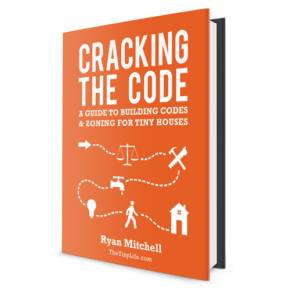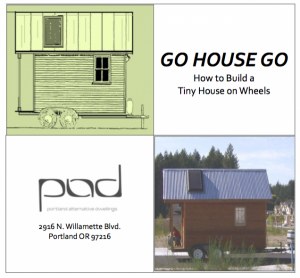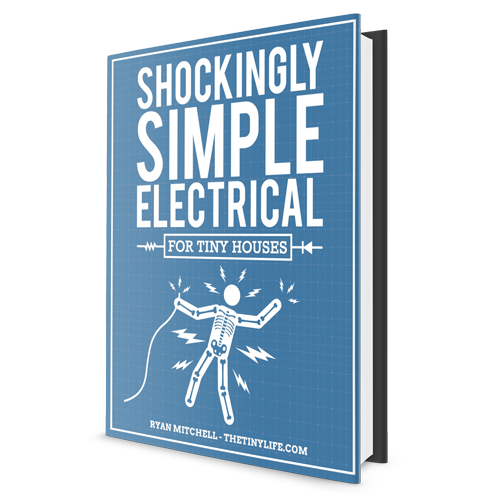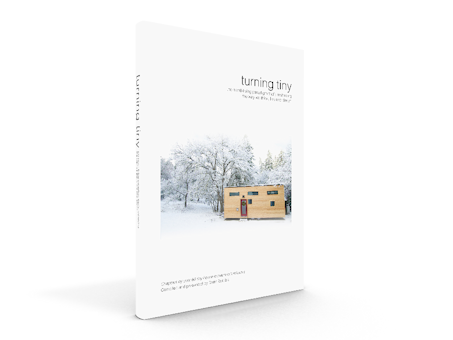 |
120 Ideas for Tiny Living Laura M. LaVoie 120 Ideas for Tiny Living is the story of how one couple downsized their lives to fit into a tiny house measuring only 120 square feet. In this book, author Laura M. LaVoie describes just 120 of the ideas they had to turn their tiny house into a home. Everything from construction to decorating to spending time in the tiny house is explored. If you've ever thought about building or living in a smaller home, this is a great resource for you. |
 |
90 Lessons for Living Large in 90 Square Feet (...or more) Felice Cohen Could you live in an apartment with 90 square feet of floor space, the area approximately the same as a Honda Accord? Could you do it for five years? And could you be happy? Felice Cohen could. And she was. A YouTube video of her astonishing use of space went viral with millions of hits. She has heard from people around the globe, many requesting the outlines of her methods. Felice's highly organized approach, gleaned from more than 20 years as a professional organizer, prepared her for the challenge of a tiny space, smack in the middle of Manhattan, where the city itself became her "extra rooms." 90 Lessons for Living Large in 90 Square Feet (...or more) is a "want to" guide on how to "live large" in any size space, the message being: eliminate clutter and focus on the things that matter. Whether you live in 90 or 9,000 square feet, this book will be of real practical and immediate value. |
 |
A Little House of My Own: 47 Grand Designs for 47 Tiny Houses Lester Walker The charming and innovative architecture of these tiny cottages, studios, fishing huts, homes and more--so small and cute that you can't help but fall for them--will inspire and delight home and architecture lovers and dreamers, too. Each chapter captures the utter eccentricity of these ingeniously designed shelters with irresistible color photographs of the structure and interiors alongside detailed isometric drawings, floor plans, and multiple elevations. A Little House of My Own offers humble dreams of solitude, romance, oasis for meditation and whimsy--all under 325 square feet--as well as technical details of the structure from the building materials and woodworking techniques to estimated cost of construction. In the accompanying text, award-winning architect Lester Walker relates the story of each building, the community or setting where it is located, and the personalities that shaped it. Notably quaint homes from history, including Jefferson's Honeymoon Cottage, Henry Thoreau's Cabin, and George Bernard Shaw's Writing Hut, and features on wacky specialty houses are sure to inspire and delight. |
 |
Builders of the Pacific Coast Lloyd Kahn |
 |
Cabin Porn Zach Klein et al. Created by a group of friends who preserve 55 acres of hidden forest in Upstate New York-Cabin Porn began as a scrapbook to collect inspiration for their building projects. As the collection grew, the site attracted a following, which is now a huge and obsessive audience. The site features photos of the most remarkable handmade homes in the backcountry of America and all over the world. It has had over 10 million unique visitors, with 350,000 followers on Tumblr. Now Zach Klein, the creator of the site (and a co-founder of Vimeo) goes further into the most alluring images from the site and new getaways, including more interior photography and how-to advice for setting up a quiet place somewhere. With their idyllic settings, unique architecture and cozy interiors, the Cabin Porn photographs, are an invitation to slow down, take a deep breath, and feel the beauty and serenity that nature and simple construction can create. |
 |
Cabins: A Guide to Building Your Own Nature Retreat David Stiles et al The best-selling Cabins is back in print, at the same great value of its original price. This authoritative how-to title gives readers all the information they need to build their own cabin, including: A useful list of essential questions to consider during the planning process; Types of cabin construction, such as pole built, stick built, post and beam, stone, cordwood, wood siding, and the advantages of each; Site preparation, foundations, windows and doors, ladders and stairs, insulation, roofing, electricity, water systems and heating; Essential information on log cabins; Cabin designs and their advantages; Furnishings and accessories; Construction methods are clearly illustrated in meticulous line drawings and precise plans with measurements. Cut-away cross-sections and exploded diagrams give the builder the true perspective and detail needed to obtain the best result, allowing readers to get the most enjoyment out of their newly built wilderness retreat. |
 |
Cracking the Code Ryan Mitchell Zoning is still a major issue for tiny homes. ADU, RVIA, ASTM, IBC... What is all of that anyway? Ryan Mitchell sets out to explain the basic issues and techniques used to zone tiny homes, and how you can use this knowledge to find a place to legally park your house, find loans, get credit, and even get insurance. While legally tiny homes are still in a gray area, this book makes the legal landscape more easily navigable for do-it-yourselfers. |
 |
Creating the Not So Big House: Insights and Ideas for the New American Home (Susanka) Sarah Susanka |
 |
Earthbag Architecture: Building Your Dream with Bags (Green Home Building) (Volume 3) Kelly Hart et al. Discover how you can build an amazing variety of structures using little more than the earth beneath your feet. Earthbag building is revolutionizing how people around the world are thinking about ways of providing shelter, both temporary and permanent. Such buildings can be remarkably durable and resistant to earthquakes, floods, fires and even bullets. Kelly Hart describes the basics of how to build this way, provides a history of the evolving technology and delves into detailed descriptions of the many different earthbag projects that he has been involved with over nearly two decades. A survey of 64 unique buildings from around the world proves just how versatile this approach to building can be. A look to the future of earthbag building and a Resource Guide complete the book. Some 240 color photographs help you visualize the possibilities of this unusual and sustainable approach to architecture. |
 |
Earthbag Building: The Tools, Tricks and Techniques (Natural Building Series) Kaki Hunter et al. Over 70 percent of Americans cannot afford to own a code-enforced, contractor-built home. This has led to widespread interest in using natural materials—straw, cob, and earth—for building homes and other buildings that are inexpensive, and that rely largely on labor rather than expensive and often environmentally-damaging outsourced materials. Earthbag Building is the first comprehensive guide to all the tools, tricks, and techniques for building with bags filled with earth—or earthbags. Having been introduced to sandbag construction by the renowned Nader Khalili in 1993, the authors developed this "Flexible Form Rammed Earth Technique" over the last decade. A reliable method for constructing homes, outbuildings, garden walls and much more, this enduring, tree-free architecture can also be used to create arched and domed structures of great beauty—in any region, and at home, in developing countries, or in emergency relief work. This profusely illustrated guide first discusses the many merits of earthbag construction, and then leads the reader through the key elements of an earthbag building. With dedicated sections on costs, making your own specialized tools, and building code considerations, as well as a complete resources guide, Earthbag Building is the long-awaited, definitive guide to this uniquely pleasing construction style. Kaki Hunter and Donald Kiffmeyer have been involved in the construction industry for the last 20 years, specializing in affordable, low-tech, low-impact building methods that are as natural as possible. They developed the "Flexible Form Rammed Earth Technique" of building affordably with earthbags and have taught the subject and contributed their expertise to several books and journals on natural building. |
 |
Go House Go Dee Williams Go House Go is a great resource for first time tiny home builders, and professional contractors alike. Dee owns her own company called Portland Alternative Designs (PAD), and while this book does specifically cover how to build houses like those offered at PAD, it takes a more generalized approach to building tiny homes on wheels, including discussions about physical stresses, tool selection, installation tips, and sound building advice for people with various levels of experience. |
 |
Handmade Houses: A Century of Earth-Friendly Home Design Richard Olsen |
 |
Home Sweet Tiny House: How to use a Garden Shed to make your own Cheap, Fun, Off-Grid Mini Cabin Mr. D A Larson The Tiny House Movement continues to grow and many people would love to embrace the concept of a tiny home, backyard art studio, writers retreat or mini cabin. The two biggest barriers however, are the cost and time commitment. The author, D. A. Larson, along with his wife and two young boys, created a fun, mobile, off-grid mini cabin in less than 3 months, part-time, and for only $3,900! D. A Larson will show you how to do this on your own for even less. You can create your own tiny house, mini cabin or artist retreat quickly and inexpensively. This book is your road map, including step-by-step instructions, and a checklist to follow. Not only will you have some great tips and shortcuts, you will also discover some great resources for finding free and cheap building materials. You can also cut your project time by 50 to 70% by starting with a garden shed. This "tiny house" shell can be easily obtained at discount pricing from local sales reps. If you are ready to create your own tiny house project, this book will help you on your way and save you time and money! |
 |
Home Work: Handbuilt Shelter Lloyd Kahn Master builder Louie Frazier's Japanese-style pole house in Northern California, reachable on a 500" cable across a river / Ian MacLeod's handbuilt stone house in South Africa, where baboons jump on the roof at night / Ma Page's bottle house in the Nevada desert / artist Michael Kahn's semi-subterranean sculptural ivillage in Arizona / Bill and Athena Steen's strawbale houses / Ianto Evans' cob houses in Oregon / the Archlibre group of countercultural builders in the French Pyrenees / Bill Coperthwaite's spectacular 3-story yurt in the Maine woods / Bill Castle's finely-crafted log home and sauna in the NY Appalachians / a commune in the Tennesee mountains / the "Flying Concrete" brothers in Mexico and their far-out sculptural structures / Barns in California, Washington, and Connecticut / Photo-essays of Lloyd Kahn's trips to Nevada, the Mississippi Delta, Costa Rica, Nova Scotia, and Baja California / Photos of buildings all over the world by photographers Yoshio Komatsu and Kevin Kelly + more, lots more. . .I get excited just listing these things! -LK |
 |
Humble Homes, Simple Shacks, Cozy Cottages, Ramshackle Retreats, Funky Forts: And Whatever The Heck Else We Could Squeeze In Here Derek "Deek" Diedricksen Derek Diedricksen has always had a love for small, modest houses ever since his father gave him the book Tiny Tiny Houses by Lester Walker for his tenth birthday. Combining his artistic abilities, wild imagination, and his passion for small houses, he self-published Humble Homes, Simple Shacks, Cozy Cottages, Ramshackle Retreats, Funky Forts, and Whatever the Heck Else we could Squeeze in Here in 2009. This book is a collection of Diedricksen’s creative/imaginative sketches for building small houses, shacks, cottages, and forts. The sketches are accompanied with hand-written commentary, both instructive and comical. Derek’s main purpose is to get your creative juices flowing and encourage you to get off the couch and use your hands. Believing that specific building plans squash creativity, he avoids too many detailed instructions, giving you the chance to put your own creative spin on your very own small abode (even if it is just in your imagination). |
 |
Little House on a Small Planet, 2nd: Simple Homes, Cozy Retreats, and Energy Efficient Possibilities Shay Salomon et al. A guidebook to planning, building, renovating, and inhabiting an eco-friendly small house. To get more information on how to live simply visit: www.littlehouseonasmallplanet.com |
 |
Living Large in Our Little House: Thriving in 480 Square Feet with Six Dogs, a Husband, and One Remote--Plus More Stories of How You Can Too Kent Griswald and Kerri Fivecoat-Campbell Based on the successful blog, Living Large in Our Little House, the book is a practical and inspirational memoir about the joy and freedom of tiny house living. Traditionally, the American Dream has included owning a house, and until recently that meant the bigger the better. McMansions have flourished in suburbs across the country, and as houses got bigger we filled them with more stuff. Kerri Fivecoat-Campbell had been subconsciously trying to live up to this American Dream when circumstances forced her and her husband into a 480-square foot house in the woods. What was supposed to be a writing cabin and guest house became their full-time abode and they quickly discovered that they had serendipitously discovered a better way of life. They realized that by living smaller, they were in fact, Living Large. They were not spending extra time cleaning and maintaining the house, but had the freedom to pursue their hobbies; they did not waste money on things they didn’t need; and they grew emotionally (as well as physically) closer. Kerri and her husband realized that Living Large is less about square footage and more about a state of mind. |
 |
Microshelters: 59 Creative Cabins, Tiny Houses, Tree Houses, and Other Small Structures Derek "Deek" Diedricksen If you dream of living in a tiny house, or creating a getaway in the backwoods or your backyard, you’ll love this gorgeous collection of creative and inspiring ideas for tiny houses, cabins, forts, studios, and other microshelters. Created by a wide array of builders and designers around the United States and beyond, these 59 unique and innovative structures show you the limits of what is possible. Each is displayed in full-color photographs accompanied by commentary by the author. In addition, Diedricksen includes six sets of building plans by leading designers to help you get started on a microshelter of your own. You’ll also find guidelines on building with recycled and salvaged materials, plus techniques for making your small space comfortable and easy to inhabit. |
 |
Select and Convert Your Bus into a Motorhome on a Shoestring Ben Rosander |
 |
Shelter Lloyd Kahn Shelter is many things - a visually dynamic, oversized compendium of organic architecture past and present; a how-to book that includes over 1,250 illustrations; and a Whole Earth Catalog-type sourcebook for living in harmony with the earth by using every conceivable material. First published in 1973, Shelter remains a source of inspiration and invention. Including the nuts-and-bolts aspects of building, the book covers such topics as dwellings from Iron Age huts to Bedouin tents to Togo's tin-and-thatch houses; nomadic shelters from tipis to "housecars"; and domes, dome cities, sod iglus, and even treehouses. The authors recount personal stories about alternative dwellings that illustrate sensible solutions to problems associated with using materials found in the environment - with fascinating, often surprising results. |
 |
Shockingly Simple Electrical Ryan Mitchell This book covers basic electrical concepts like circuits, volts, watts and explains practices used by real electricians. While you should still consider at least talking to an electrician about your project, this book offers the basic techniques you need to wire your house. You can save a bit of money using this book if you want to wire your home yourself and have a professional look over (and sign off on) your work. |
 |
The Fifty Dollar and Up Underground House Book Mike Oehler et al. |
 |
The Big Tiny: A Built-It-Myself Memoir Dee Williams When do-it-yourselfer Dee Williams was diagnosed with a terminal heart condition at 41 in the early 2000's, she felt the weight of her life strike her like a ton of bricks. Life was too short to be worrying about work, mortgages, and possessions. Instead, craving family, friends, and freedom, she built one of the first portable tiny homes by herself in a friend's driveway. This memoir is funny, sorrowful, heartfelt, and genuine down to the last page. Dee's experience of discovering tiny homes is as much spiritual as it is practical, and I would recommend it for anyone seriously interested in tiny homes. |
 |
The Box: How the Shipping Container Made the World Smaller and the World Economy Bigger, Second Edition with a new chapter by the author Marc Levinson |
 |
The Cob Builders Handbook: You Can Hand-Sculpt Your Own Home, 3rd Edition Becky Bee |
 |
The Hand-Sculpted House: A Practical and Philosophical Guide to Building a Cob Cottage: The Real Goods Solar Living Book Ianto Evans et al. |
 |
The Humanure Handbook: A Guide to Composting Human Manure, Third Edition Joseph C. Jenkins There's a reason you've heard a lot about those composting toilets that seemingly all tiny homers use. The reason is this book. Jenkins was just an ordinary Joe: he had a few kids, a wife, a garden, a home. That was until he started thinking about toilets. A little bit too much, probably. He was amazed to realize that people essentially do their business in drinking water, and how that polluted water is becoming a huge environmental strain on our oceans, our health, our landfills, and our economy. Curious, he started collecting information on what we could do to curb the problem. The result is a thoroughly researched, clever, funny, and shocking book about humanure that will make you feel uncomfortable using a flush toilet ever again. This book offers common sense practices for re-using and recycling our waste in responsible ways that will actually be more hygienic, safer and cleaner than using a septic system or a traditional flush toilet. Yes, I said cleaner, safer, and more hygienic than a flush toilet. Think about it. |
 |
The Life-Changing Magic of Tidying Up: The Japanese Art of Decluttering and Organizing Marie Kondo Japanese writer Marie Kondo is a professional tidy person. She owns a Tokyo-based consulting business designed to help her clients let go of their possessions and put their lives in order using a simple technique: if what you own sparks joy, you keep it. If not, there is simply no room for it in your life. Her book challenges its readers to seriously consider the objects we have in our lives: are our possessions enhancing our lives? How would our possessions feel knowing their owners stuff them away in a closet eight months out of the year? Would they be happier and better cared for elsewhere? An enjoyable read, an every-day exercise in mindfulness, and a packed with critical information for anyone considering living in a tiny home. |
 |
The Not So Big House: A Blueprint for the Way We Really Live Sarah Susanka et al. |
 |
The Small House Book Jay Shafer |
 |
Tiny Homes on the Move: Wheels and Water Lloyd Kahn |
 |
Tiny Homes: Simple Shelter Lloyd Kahn |
 |
Tiny House Design & Construction Guide Dan S Louche One of the few how-to-books for tiny homes on the market, Dan Louche's book covers the basics in designing, framing, and building your own tiny home on wheels. Reviews of this book are overall positive and his second edition contains more content and illustrations than the last. The major advantage of this book is that it explicitly covers tiny homes on wheels, and contains professional advice that will prove more than useful in the long run. |
 |
Tiny House Floor Plans: Over 200 Interior Designs for Tiny Houses Michael Janzen |
 |
Tiny House Living: Ideas For Building and Living Well In Less than 400 Square Feet Ryan Mitchell |
 |
Tiny House Living: Tiny Home Woodworking Plans & Interior Design Ideas For Living In Less Than 400 Square Feet And Feel Large (Tiny House Movement And Tiny Homes For Beginners) Tamra Brookings |
 |
Tiny House Parking: How to Find Safe, Practical, and Affordable Land for Your Tiny House Ethan Waldman |
 |
Tiny House: Remarkable Beginners Guide to Interior Design, Affordable Living, and 50 Hacks for Ginormous Living! (Housing Lives Matter!) (Volume 1) Michael Scott Reeves et al. |
 |
Tiny House: The Definitive Manual To Tiny Houses: Home Construction, Interior Design, Tiny House Living Mason Algarotti |
 |
Tiny Houses Built with Recycled Materials: Inspiration for Constructing Tiny Homes Using Salvaged and Reclaimed Supplies Ryan Mitchell |
 |
Tiny Tiny Houses: or How to Get Away From It All Lester Walker |
 |
Turning Tiny Et al |
Comments
Buried with Summit preparation--we'll get to this after the event!
Let us know here if you'd like to suggest a book for this list. Also please note that the links for these books contain an affiliate marketing code with Amazon to help support the Tiny House Summit.